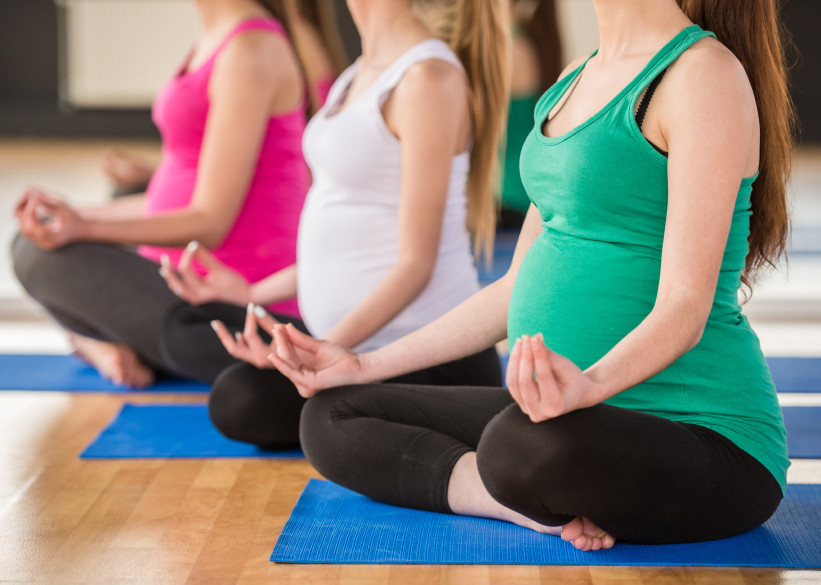Harvard Health Blog
Yoga in pregnancy: Many poses are safer than once thought

Prenatal yoga is typically gentle, with certain poses modified or avoided depending on the stage of pregnancy. But a new study, published recently in the journal Obstetrics and Gynecology, provides encouraging results that many yoga poses can be safe even during late stages of pregnancy.
Testing the safety of various yoga poses
For the study, the researchers invited 25 women between 35 and 38 weeks of pregnancy to take part in a yoga session. They included women with previous yoga experience as well as those who were new to the practice. All of the women were generally healthy and free of pregnancy-related or other health issues like high blood pressure or gestational diabetes.
The yoga session consisted of 26 poses, including some (such as Happy Baby pose and Corpse pose) that are often avoided during pregnancy. Several poses, including balancing poses like Half Moon, Warrior III, and Tree, were modified by using blocks, chairs, or a wall.
During the session, the researchers monitored each woman's blood pressure, heart rate, temperature, oxygen levels, and uterine contractions, as well as the fetal heart rate — a measure of a baby's well-being. All vital signs of both mother and baby were normal during the poses and after the session. There were no falls, injuries, or safety problems.
The researchers also followed up with each participant via email 24 hours after the session. All the women reported feeling safe during the yoga poses. None of them had any problems later with contractions, vaginal bleeding, or reduced movement of the baby. All of the women, except three who described muscle soreness, expressed only positive experiences with the yoga session. The researchers concluded that the 26 different yoga poses — including those that were previously avoided — were safe for both the mothers-to-be and their babies.
Here is a list of the 26 poses from the study. The poses marked with an asterisk (*) were previously thought to be contraindicated during pregnancy.
| 1. Easy pose, Sukhasana
2. Seated forward bend, Paschimottanasana 3. Cat pose, Marjaryasana 4. Cow pose, Bitlasana 5. Mountain pose, Tadasana 6. Warrior I, Virabhadrasana I 7. Standing forward bend, Uttanasana 8. Warrior II, Virabhadrasana II 9. Chair pose, Utkatasana 10. Extended side angle pose, Utthita Parsvakonasana 11. Extended triangle pose, Utthita Trikonasana 12. Warrior III, Virabhadrasana III 13. Upward salute, Urdhva Hastasana |
14. Tree pose, Vrksasana
15. Garland pose, Malasana 16. Eagle pose, Garudasana 17. Downward-facing dog, Adho Mukha Svanasana* 18. Child's pose, Balasana* 19. Half moon pose, Ardha Chandrasana 20. Bound angle pose, Baddha Konasana 21. Hero pose, Virasana 22. Camel pose, Ustrasana 23. Leg up wall pose, Viparita Karani 24. Happy baby pose, Ananda Balasana* 25. Half Lord of the fishes pose, Ardha Matsyendrasana 26. Corpse pose, Savasana* |
This study suggests that yoga can be safe during late pregnancy and adds to the growing scientific evidence that yoga is a helpful, safe tool to reduce stress, anxiety, and depression throughout pregnancy. Over half of all women experience anxiety at some point during pregnancy, and about 13% of pregnant women experience clinical depression. Yoga has been shown to ease stress and anxiety during pregnancy and to reduce levels of the stress hormone cortisol. Several studies of yoga during pregnancy have found it is also effective for reducing depression, particularly when it is started early in the pregnancy and can be combined with standard depression treatment. Yoga can also reduce pain and discomfort, as well as improve overall quality of life during pregnancy.
Prenatal yoga is particularly effective as part of an integrated approach that includes breathing exercises, meditation, and deep relaxation.
How to make the most of yoga during pregnancy
Moms-to-be should focus more on stability and strength, rather than endurance and flexibility. Use modifications, props, or a wall to make each pose well-supported. Pregnancy hormones loosen your muscles and ligaments, which increases the risk for injuries if you push yourself too far in terms of flexibility. This is true even in the first trimester. Another hormone called relaxin, which is at its highest levels in the first trimester and relaxes muscles, tendons, and ligaments, also peaks in the first trimester. This laxity means you can accidentally over-stretch your joints and muscles.
Finally, some forms of yoga done in extreme heat, like Bikram yoga, where the room can be up to 105 degrees Fahrenheit, are not recommended during pregnancy. There are currently no studies that can tell us whether heated yoga is safe for pregnant women. But we do know heated yoga tends to raise core body temperature, which can pose significant risks for both mother and baby. Heat also loosens ligaments further and increases the risk of overheating and dehydration.
Yoga offers many benefits during pregnancy. But if you're pregnant and you want to try yoga, do check with your doctor first.
Disclaimer:
As a service to our readers, Harvard Health Publishing provides access to our library of archived content. Please note the date of last review or update on all articles.
No content on this site, regardless of date, should ever be used as a substitute for direct medical advice from your doctor or other qualified clinician.















